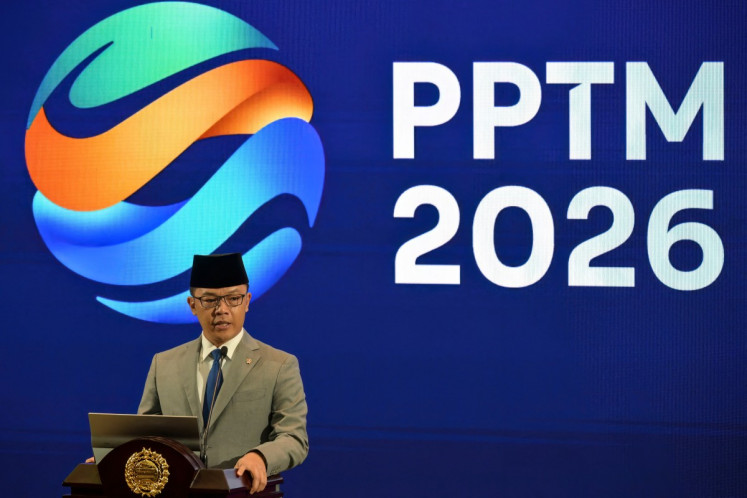Popular Reads
Top Results
Can't find what you're looking for?
View all search resultsPopular Reads
Top Results
Can't find what you're looking for?
View all search resultsDidiet Maulana: It's all about the fabric
(JP/Novia D
Change text size
Gift Premium Articles
to Anyone
 (JP/Novia D. Rulistia)" border="0" height="428" width="511">(JP/Novia D. Rulistia)
(JP/Novia D. Rulistia)" border="0" height="428" width="511">(JP/Novia D. Rulistia)Rising Indonesian designer Didiet Maulana once had to drop his dream of becoming a fashion designer because he thought he did not have the ability.
His drawing talent was then channeled to architecture as he enrolled in the architecture school at the Parahyangan Catholic University in Bandung, West Java.
âIâve always liked drawing since I was a boy, and I realized I also enjoyed drawing the designs for clothes,â Didiet said.
âBut then I chose to wave goodbye to fashion and went to architecture school, because I didnât think I was skillful enough to be a designer,â said the 32-year-old.
Upon graduating from college he tried many professions, including working in a creative division at MTV Indonesia.
But it was his professional experience in marketing at a fashion retail company for seven years that prompted him to start pursuing his once-forgotten dream of becoming a designer.
He quit and decided to establish his own brand in 2011, Ikat Indonesia, with a mission to develop an Indonesian woven fabric called tenun ikat as the focus of his fashion line.
âAt that time, everyone was busy talking about Indonesiaâs culture and natural resources being claimed by other countries, but they did nothing about it. Rather than just sit around and listen to the debate, I decided to do something,â Didiet said.
His mission to help promote the richness of the archipelago was materialized as Didiet was trusted to design the outfits of finance ministers and their deputies, as well as for Sri Mulyani Indrawati, World Bank managing director and former Indonesian finance minister, for the 2013 APEC Summit in Bali.
âI feel flattered of course. I had the chance to promote Indonesiaâs traditional textiles and my country, too. I want to show the international quality of Indonesian products,â he said.
Didiet said that in the outfit package he had attached a short story on how tenun was made so they could appreciate the textile more and understand all the efforts that had gone into producing it.
âI think the stories of products that are part of Indonesiaâs culture must be told, because thatâs our strength. Behind the fabric, there are people working on it,â he said.
The process of getting involved in APEC itself was quite challenging for him.
He was contacted by the organizers who said he was a candidate that would design outfits for the VIPs two months before the summit took place.
(JP/Novia D. Rulistia) Rising Indonesian designer Didiet Maulana once had to drop his dream of becoming a fashion designer because he thought he did not have the ability. Best dressed: APEC finance ministers wearing traditional batik specially designed by Didiet Maulana, pose for a group photo in Nusa Dua, Bali. (AP/Firdia Lisnawati)
His drawing talent was then channeled to architecture as he enrolled in the architecture school at the Parahyangan Catholic University in Bandung, West Java.
'I've always liked drawing since I was a boy, and I realized I also enjoyed drawing the designs for clothes,' Didiet said.
'But then I chose to wave goodbye to fashion and went to architecture school, because I didn't think I was skillful enough to be a designer,' said the 32-year-old.
Upon graduating from college he tried many professions, including working in a creative division at MTV Indonesia.
But it was his professional experience in marketing at a fashion retail company for seven years that prompted him to start pursuing his once-forgotten dream of becoming a designer.
He quit and decided to establish his own brand in 2011, Ikat Indonesia, with a mission to develop an Indonesian woven fabric called tenun ikat as the focus of his fashion line.
'At that time, everyone was busy talking about Indonesia's culture and natural resources being claimed by other countries, but they did nothing about it. Rather than just sit around and listen to the debate, I decided to do something,' Didiet said.
His mission to help promote the richness of the archipelago was materialized as Didiet was trusted to design the outfits of finance ministers and their deputies, as well as for Sri Mulyani Indrawati, World Bank managing director and former Indonesian finance minister, for the 2013 APEC Summit in Bali.
'I feel flattered of course. I had the chance to promote Indonesia's traditional textiles and my country, too. I want to show the international quality of Indonesian products,' he said.
Didiet said that in the outfit package he had attached a short story on how tenun was made so they could appreciate the textile more and understand all the efforts that had gone into producing it.
'I think the stories of products that are part of Indonesia's culture must be told, because that's our strength. Behind the fabric, there are people working on it,' he said.
The process of getting involved in APEC itself was quite challenging for him.
He was contacted by the organizers who said he was a candidate that would design outfits for the VIPs two months before the summit took place.
As the meeting was taking place in Bali, Didiet wanted to use local tenun, and thankfully, he already had the textile in stock. It took about two months to make one piece of tenun ikat.
'What was more challenging was that I didn't have the actual size of most ministers, so I just searched for their profiles through the Internet. The fitting itself took place a day before,' he said. 'But everything worked out well.'
Besides tenun in Bali, Didiet has also developed materials from Jepara, Makassar, Padang and
Palembang.
His first meeting with tenun was when he went to Jepara and found a tenun-making village in the city, Troso. Seeing the opportunity to further develop the tenun area, he then asked local weavers to team up with him as soon as he established Ikat Indonesia.
'I told them my idea and they translated it well on the fabric,' said the designer who cooperated with 19 local weavers in five cities.
He pointed out there were many little known tenun centers throughout Indonesia.
'The magical thing is that after you find a tenun center, you will immediately find other tenun-producing areas in the same city that are still untouched,' he said.
As the new kid on the block who brought a new concept to the fashion scene, Didiet didn't find any difficulties when he first launched his collection.
His network of celebrities and the media made it easy to introduce his work.
And although he did not have any educational background in fashion, he was not shy of competing with other fashion designers.
Didiet, a fan of senior designer Edward Hutabarat, said he'd learned all the techniques required on the job.
'I think the most important thing is my commitment as a designer, followed by the ability to read the trends and the use of logic, which I learned from architecture. Fashion design is a fantasy world, but you have to balance the fantasy with logic,' Didiet said.
He said architecture and fashion design were closely related, because in architecture, an architect who drew the designs had to know how to build the design, taking into account technical and mathematical aspects.
'In fashion design, I have to know what the cutting will be like, how the finishing is and how the ideas in my head can be translated into the materials that I have. Everything must be measured,' said Didiet, who is famous for structural patterns in his designs.
And after more than two years in the business, his designs are not only worn by women, but also by men through its Pour Homme collection and Svarna collection for brides.
For the future, increasing production capacity and reading future trends at home and abroad are at the top of his in-tray, as he has received many offers to have his designs sold abroad.
'I need to improve my capacity first, because once you go international, once you go mass, you won't have any excuse to slow down,' said Didiet, who is also a deputy of the creative industry committee at the Indonesian Chamber of Commerce and Industry (Kadin).
He also keeps himself busy by figuring out ways of redeveloping tenun villages by involving more young people in the industry.
'Most weavers are senior people and as part of my job in Kadin, I'm planning to create a bigger market for tenun ikat while encouraging youth to develop the industry, because the economic potential is huge,' Didiet said.
Your Opinion Matters
Share your experiences, suggestions, and any issues you've encountered on The Jakarta Post. We're here to listen.
Thank You
Thank you for sharing your thoughts. We appreciate your feedback.
Share options
Quickly share this news with your network—keep everyone informed with just a single click!
Gift Premium Articles
to Anyone
Share the best of The Jakarta Post with friends, family, or colleagues. As a subscriber, you can gift 3 to 5 articles each month that anyone can read—no subscription needed!
Continue in the app
Get the best experience—faster access, exclusive features, and a seamless way to stay updated.










